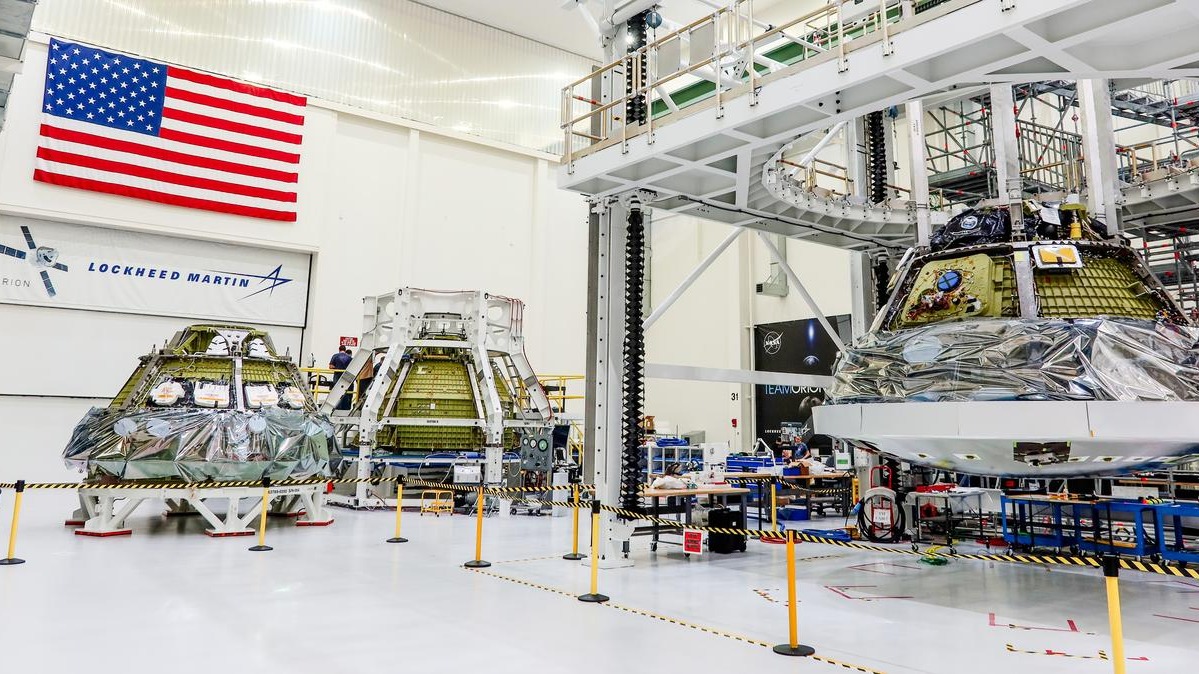These 3 Orion spacecraft will carry Artemis astronauts to the moon (photo)
A trio of mooncraft met in an assembly room.

Three crew-carrying spacecraft are getting ready for their big moon missions.
The Orion capsules for the Artemis 2, Artemis 3 and Artemis 4 moon missions are coming together at NASA's Kennedy Space Center in Florida under stewardship of contractor Lockheed Martin.
"The future of @NASA_Orion is looking pretty good," Lockheed officials wrote on Twitter Friday (July 14) of the three spacecraft, each of which is expected to ferry astronauts to the moon starting in late 2024 or so.
Related: Four for the moon! NASA names Artemis 2 astronaut crew for 1st lunar mission since Apollo
Artemis 2 will send Orion the moon in November 2024 with an already-named crew of four astronauts, while we are still awaiting word of who will fly the Artemis 3 and 4 missions for later in the decade.
Artemis 2 includes NASA astronauts Reid Wiseman, Victor Glover and Christina Koch, along with Canadian Space Agency astronaut Jeremy Hansen. Artemis 3 and 4 will both include astronauts from NASA and the European Space Agency.
Artemis 3 is currently scheduled to launch in 2025 or 2026, pending readiness of the SpaceX Starship system that will ferry some of the crew to the surface. Artemis 4 would then follow later in the 2020s, if current schedules hold.
Breaking space news, the latest updates on rocket launches, skywatching events and more!
Lockheed Martin is under contract to deliver Orion spacecraft for future Artemis moon missions across several delivery orders. In recent years, the orders for Artemis 3 through 5 had values of $2.7 billion, while Artemis 6 through 9's order is worth $1.9 billion. Lockheed officials previously stressed that building the spacecraft in groups allows them the company realize cost savings via production efficiencies.
Not shown in the new picture is the Orion spacecraft for Artemis 1, which aced an uncrewed trip to lunar orbit late last year to prepare for these human missions. Nor is the first-ever Orion produced for space visible; it circled Earth in 2014 on a test flight.
NASA and 26 other nations are signed on to the Artemis Accords, which aim to establish norms for peaceful lunar exploration. Canada and the European Space Agency have both committed to providing hardware for Artemis and the planned Gateway space station that NASA plans for the moon in the 2020s.

Elizabeth Howell (she/her), Ph.D., was a staff writer in the spaceflight channel between 2022 and 2024 specializing in Canadian space news. She was contributing writer for Space.com for 10 years from 2012 to 2024. Elizabeth's reporting includes multiple exclusives with the White House, leading world coverage about a lost-and-found space tomato on the International Space Station, witnessing five human spaceflight launches on two continents, flying parabolic, working inside a spacesuit, and participating in a simulated Mars mission. Her latest book, "Why Am I Taller?" (ECW Press, 2022) is co-written with astronaut Dave Williams.
